Yeah, this one took a bit of a long while to make... mostly because I really can't bring myself to really find these books, or at least borrow them from someone who has purchased them.
And... I'm sorry, I just kind of find the adventure modules set in Waterdeep not that interesting to read; I've never listened to the actual 'Acquisitions Incorporated' podcast so their book (which has brilliant artwork, though) sort of flew over my head; and I've never been the most interested in the Eberron setting; at least not enough to read two entire think tomes about them. That's less Eberron's fault, though -- I really just don't find books about settings and planes the most interesting to read. That's more of a me problem, really.


All of these books are released in 2018, and they sure are great, but I just find myself not really finding too much motivation to really read them too deeply, and I feel that if I don't at least have a good grasp of what's going on in the book, I wouldn't be able to talk about the monsters and flavour within it particularly well.
The thing is... Guildmaster's Guide to Ravnica features a lot of things, and many of those things are just adaptations of characters or cards from the Magic: The Gathering expansion of the same name. Which is going to always be hard. I am aware of Ravnica's backstory and whatnot, but I feel like it's going to take just a bit too long for me to talk about it, so I'll be skipping Guildmaster's Guide to Ravnica for the time being. There's just too much in that, and while I know it'll be a while until I get there, I am also reviewing Magic: The Gathering cards and monsters. So... I dunno, I just kept looking and staring at the pdf and really can't come up with much without talking about the setting and the guilds and stuff.
Still, having D&D crossover with Magic is pretty great, though, and Ravnica for one is certainly the perfect sandbox to toss your characters in. For the most part, they basically canonize some of the more popular races in Ravnica (and M:TG) as playable characters -- we get the Magic-unique Vedalken and Simic, as well as getting stats for Centaurs, Minotaurs and Loxodons. We'll talk about those when we talk about Ravnica proper.
The two Waterdeep modules act as a two-parter adventure similar to the Dragon Queen Saga, dealing with, well, a heist and all the wacky conspiracies happening in the massive sparwling city of Waterdeep, itself split apart into various factions by the various syndicates that vie for power within it.



Acquisitions Incorporated has very fun art, and is a sourcebook created by the live-stream gaming group of the same name, starring a bunch of adventurers who form a pseudo-corporate group in a quest for fame and wealth. Again, with these sort of 'tie-in' sourcebooks you really do kind of need to know a fair bit about the characters and setting in question to truly appreciate it. Being a longtime Critical Role fan, I certainly do when they actually published an official WOTC-sponsored sourcebook. I'll just preface this with a bit of a disclaimer -- I don't really know what's going on there and the lore I can glean are from my readthrough of the book.
And then there is Eberron. As a rule, I'm honestly someone who very much appreciate but don't get too excited about reading a 200-tome-book about a setting. I honestly kinda wished that they actually 'migrated' some of the best parts of Eberron into the Forgotten Realms just like what they did with Ravenloft and Curse of Strahd, but I also recognize that the whole appeal of Eberron is that it's a unique setting. Just like with the Ravnica sourcebook, the Eberron books also serve as essentially 'canonizing' some of the setting's most popular races (Warforged!) into a more generic D&D setting. A lot of my favourite aspects and tropes in D&D and role-playing in general is grandfathered from Eberron, although I'll refrain from actually elaborating on what they are until I actually know what I'm talking about.
_______________________________________________
Waterdeep


Many of the new enemies in Waterdeep: Dragon Heist also show up again in Waterdeep: Dungeon of the Mad Mage. TL;DR, your characters are hired to help to hunt down a cache of half a million gold coins hidden somewhere in the city and stop them from falling into the wrong hands. However, two groups of criminals -- the shadowy mercenary group the Zhentarim; and the Beholder-led mob called the Xanathar -- clash over obtaining that cache and the adventurers are drawn into conflict. This leads to them being embroiled in Waterdeep's politics and at some point the adventure continues as they brave Undermountain, the dungeon of the mad wizard Halaster Blackcloak.

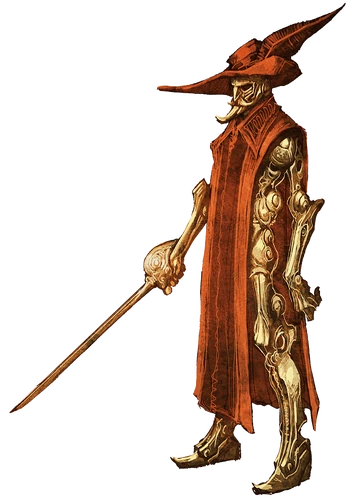
Drow Gunslinger, Griffon Cavalry Rider & Nimblewright
As with most of these 5E D&D stuff, the franchise has been growing far more and more lax with depicting things that don't quite gel into the stated idea of 'medieval fantasy all the time', which... frankly, would really kind of get boring after a while. So in addition to a whole lot (and I do mean a lot) of new NPC's and whatnot, we get a bunch of named NPC's as potential antagonists (including my favourite -- Nihiloor, a Mind Flayer who keeps Intellect Devourers like a crazy cat lady). I suppose I'll use the Drow Gunslinger common enemy here to highlight just how neatly different the 'vibe' of Waterdeep is, it's practically a couple steps away from becoming full-blown Final Fantasy. These are gunpowder pistols, which fit with the 'but not too realistic!' take on things.
Another notable fun 'generic' enemy NPC would be the Griffon Cavalry Rider, which is pretty tame as far as these things go -- and unfortunately, not depicted with her griffon in official artwork. I do really like the fact that these fantasy settings have a completely different militia; in a world where griffons, manticores, otyughs and bullettes roam, I really like that they don't just fall into the repetitive imagery of 'oh knights are on horseback duh'. They don't do this as often as I want to, but I appreciate it when they do.
I like this one, mostly thanks to the artwork. Look at that fancy-ass curled beard and that fancy beard. And that hat! And that rapier! The Nimblewrights are magical constructs created to be guards or assassins, when your mages want to be just a bit more posh and aristocratic. Not everyone wants to have dirty golems or spooky Helmed Horrors as bodygaurds, sometimes you want your magical golem to look like an extra from The Legend of Zorro or something -- the text even explicitly mention that they fight like a 'dancing swashbuckler'. Fun! Interestingly, despite the very glossy artwork, the Nimblewright isn't made of gears and metal, but from a specific type of wood! And they are apparently sophisticated enough to 'pass as human' if they wear clothes... even though their expression can never change. I mean, I guess they can wear a mask or something.

Walking Statue of Waterdeep
Speaking of golems... that is a badass image. This is our last actual generic 'enemy' from Dragon Heist, because everyone else that is statted here are characters and we don't cover those. The city of Waterdeep is guarded by eight giant statues that are only activated in great peril, because even if these giant statues are meant to guard the citizens of Waterdeep when you're the size of goddamn Godzilla the mere act of walking can cause a large amount of property damage. A bit more terrifyingly, none of the people of Waterdeep realize that the Walking Statues can be activated at all and some of them even have structures built on top of them like tourist attractions. I think one of the plot involves some of the villains fighting over an artifact that can animate these giant colossi.
Design-wise they're boring giant humanoid statues, but I really do like the trope of what they're going for here.
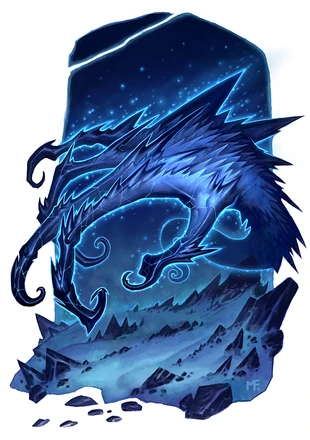

Living Spell
And just like that, we're into Dungeon of the Mad Mage, which runs 320+ pages and is just a bit too thick for me just to describe a single dungeon, but every one of my gaming group's friends swear up and down that it's one of the most fun 5E modules to play. Sure! The 'boss' of this whole endeavour is the titular Mad Mage, Halaster Blackcloak, who we'll not talk about here -- he's just a particularly mad mage, and the main facet of why he's so scary is that he's transformed his entire dungeon into what's essentially a living location bound to him.
Which brings us to the enemies known as 'Living Spells'. Which don't get any artwork in this book, but I can and will borrow artwork from 4E and 3.5E, where I first encountered these things! The Living Spells are kind of one-note, but the thing is that D&D's spells are pretty cool and sometimes you just have spells that are so powerful -- or locations that are so warped -- that even the simple act of channeling spells can cause the spells to gain a life of their own, moving around in something equivalent to a magic-created construct or an elemental.
Dungeon of the Mad Mage merely gives us stats for "Living Unseen Servant", which is a spell that makes an invisible humanoid butler, which is kind of the most boring spell you could make into a Living Spell. Previous editions have things like (pictured here) Chillspark; Glitterfire; or Living Cloudkill. Those are the sort of cool terrifying 'god damn it, what has magic borne us?' that would really be interesting.
Thankfully, the more traditional Living Spells show up in the Eberron sourcebooks, from Rising From the Last War, I believe. Created by a magical cataclysm, these are more traditional 'what if weird spells gained a life?' These three are, respectively, Living Burning Hands, Living Lightning Bolt and Living Cloudkill. Living Cloudkill isn't quite as epic as that 4E artwork up above, but it's still pretty neat! I also do like how Living Burning Hands doesn't quite look like a normal person's hands, but more like a mass of fire that is vaguely molded after a hand. Neat.

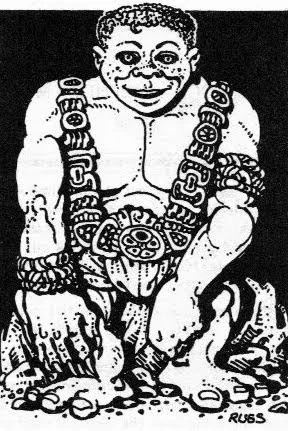
Lava Child
Uuuhhh... okay, these guys are a bit weird. Lava Children first showed up in the 1st Edition Fiend Folio and is sort of one of the creatures from that tome that I felt to be pretty dang boring considering how insane the rest of the original Fiend Folio was. The Lava Children are apparently always grinning and always have the same faces, and are born in the 'Fountains of Creation', located in the elemental plane of magma -- which is where the elemental planes of earth and fire intersect. And... they sort of just there, living and being able to move through metal since they're made out of lava? They're always smiling but very much able to rip you limb to limb? And they reproduce by laying eggs? I really wished that the visual design communicated this a bit better instead of just showing us literally just some dude with pants and suspenders. Although I do really have to give kudos to whoever did the 5E artwork, the combination of that grin and beady eyes makes the Lava Child look terrifying. Other than that, though, they could've stood to be just a bit more unsettling.
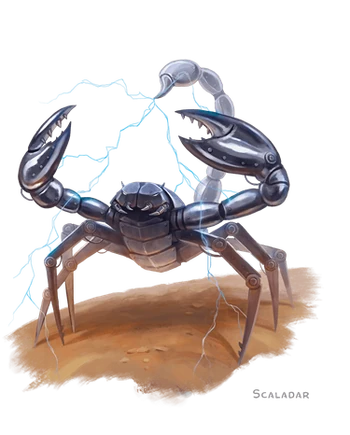
Scaladar
Metallic scorpion constructs! That's a bit cooler, and apparently these are created specifically by one of Halaster's apprentices and will not harm anyone who's holding one of the apprentice's rings. Instead of poison, because this is a robot scorpion, its stinger shoots out lightning. Hilariously, if two people hold two rings and give differing commands, the Scaladar will blue-screen itself and shut down for an hour. Other than that, though, they're an all right addition to the denizens of the dungeon of a mad-mage, just maybe not quite mad enough. We've seen many metal animals and many scorpions in D&D before.
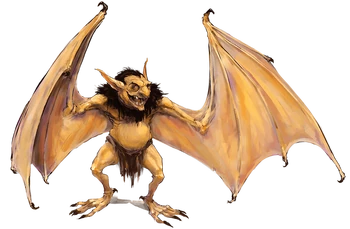
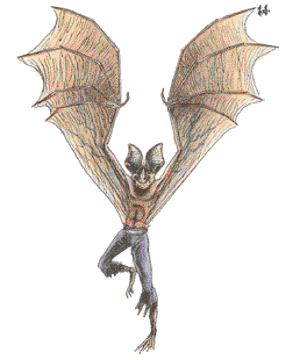
Werebat
Look at that goofy-ass grin on the 5E Werebat artwork, he just looks so happy to be included after constantly being skipped over for 'cooler' Weretigers and Wereboars. Apparently most Werebats are derived from goblins, which... I wouldn't associate goblins with bats, but okay, sure, I guess they both live in caves or something? They basically are Man-Bat from DC comics, just a bat with a human's (well, goblin, in this case) torso and longer legs. Apparently all Werebats are also somewhat vampiric in that they need to feed on at least one pint of fresh blood every night to survive. You'd think that they would include Werebats a bit more in the more Gothic-horror-themed settings, but hey. I like these guys, they look goofy.
A lot more comical compared to, say, the werebats from Elder Scrolls lore, but I like them.
_____________________________________________________________
ACQUISITIONS INCORPORATED
Next up (again, we're skipping Guildmaster's Guide to Ravnica) is the Acquisitions Incorporated sourcebook with their glorious cartoony artwork.

Verdan
As with most of these 'splatbook' sourcebooks, Acquisitions Incorporated adds a new playable race. The Verdan are apparently transformed from goblins and hobgoblins doing 'regular goblinoid things' when they passed through the shadow of 'That-Which-Endures', which I'm going to assume is some sort of eldritch god-like entity unique to the Acquisitions Inc. storyline which I'm not going to look up too much of the details about because I do want to enjoy this show at some point.
That said, other than some new gameplay mechanics and traits, I don't really feel like there's too much to talk about the Verdan. They're goblins that, upon reaching a dramatic puberty sprout, ends up looking more like green-skinned half-elves. I'm personally never a big fan of this, the style that 'oh, you must look more traditionally humanoid when you become more enlightened in intelligence', but the Verdan themselves will also happily accept any sort of changes in physical features, skin colouration and even gender, all of which can change when they become true adults. Definitely a bunch of metaphors in there! A good chunk of the appeal in playing a Verdan is that they're a new race, forcibly ejected from the Underdark into the upper world, and they are still discovering their place in the world, adopting the cultural practices of whoever's nearby but also not feeling like they belonged. Visually they're honestly not too different, but I really do like the fact that this race is basically built to tell a story.
Chaos Quadropod
A lot of the monsters in this sourcebook are a bit more tongue-in-cheek, but I appreciate that in my D&D campaigns. After all, the wackier a monster is, the more memorable it is, right? This 'Chaos Quadropod' is a creature from the eldritch Far Realm, and that artwork is actually deliberate -- it's not "part of the creature is unseen". Rather, its central body is explicitly a 'pulsing mass of ethereal light' with four octopus tentacles jutting out of it. Pretty fun description, actually, and a simple yet effective way to communicate how otherworldly this creature is.
Clockwork Dragon
I never actually considered that any sort of 'construct' dragon in D&D-world would actually be a parallel for the actually existing metallic dragons. Huh! The Clockwork Dragon, as seen here, has an anatomy that feels more in common with a Behir, though, with a long, serpentine body and many centipede-like legs running down its frame. I have always adored the term 'clockwork' when it's used to describe a robotic creature. Also, being a constructed robot dragon, this means that the Clockwork Dragon's breath weapon wholly depends on what its creators installed within it.
Deep Crow
Oh, this one is cool. This one is very very cool. Crow monsters are pretty common in fantasy setting, but these Deep Crows are more like hideous demon-gargoyles with four limbs, a somewhat dragon-like tail, but that head! Look at it from a distance and it does look just like a jagged crow head, but look a bit closer and you realize that there's a cluster of glowing eyes, and a second pair of beaks that have emerged from the sides of its mouth like some sort of an insect mandible. Apparently speculated to be abandoned familiars of evil arcane casters that ended up growing and mutating, the Deep Crow is explicitly noted to be an "avian insect" that has perfectly adapted into living in the subterranean caverns of the world.
Interestingly, these Deep Crows are noted to be particularly terrible when holding a grudge, and would even teach their chicks about the people that they despise, creating a 'cross-generational hatred'. So these Deep Crows have the same vendetta that many lazy adventurer backstories have. Good to know! Larger and far more terrifying versions called "Ancient Deep Crows", the size of Giants and Dinosaurs, also exist. Granted, a couple of books down the line and we'd get the Dire Corby, another form of subterranean monster crow, but I am definitely happy that D&D 5E gives us two completely different versions of demon-crows to draw from.
Keg Robot
Our last bestiary creature in Acquisitions Incorporated (disregarding NPC's, of course) is the Keg Robot. Of course a setting like D&D would have any enterprising robot-making people create alcohol-related constructs! I like that apparently the "HARD division" (hee hee) gives a whole lot of justification to creating this, like a portable fermenter or whatever, but everyone knows it's just there to make beer for adventurers. I love this guy, he is a keg with a cartoony robot head, little arms and legs that look like a toy for a three-year-old child... and while it's easy to miss thanks to the artwork being a cross-section, a spigot for dispensing ale right at the robot's crotch. D&D and toilet humour go hand-in-hand.
_______________________________________________Our last bestiary creature in Acquisitions Incorporated (disregarding NPC's, of course) is the Keg Robot. Of course a setting like D&D would have any enterprising robot-making people create alcohol-related constructs! I like that apparently the "HARD division" (hee hee) gives a whole lot of justification to creating this, like a portable fermenter or whatever, but everyone knows it's just there to make beer for adventurers. I love this guy, he is a keg with a cartoony robot head, little arms and legs that look like a toy for a three-year-old child... and while it's easy to miss thanks to the artwork being a cross-section, a spigot for dispensing ale right at the robot's crotch. D&D and toilet humour go hand-in-hand.
Eberron



Hey-ho, Eberron! One of the most well-regarded and most popular D&D settings, Eberron was created and ultimately released in 2004 under D&D's 3E imprint when Wizards of the Coast went out in search of a 'new setting'. And the result is a very fun blend of what people have described as a fantasy version of pulp adventure, film noir and 'magi-tech'. And it tries to keep the setting still in fantasy, but not bogged down in medieval dark-ages humdrum that most of D&D can feel like it is. I'll confess to not knowing all that much about Eberron, but I know that its introduction has really been instrumental in influencing a lot of the 4E and 5E material that came afterwards, particularly in avoiding tropes that have thankfully became outdated, like the idea of a 'always chaotic evil' race. One of the 5E books even has a segment called 'monsters aren’t always villains, and the villains aren’t always monsters', which, if you can't already tell, is one of my favourite tropes.
Eberron's setting, as described in the many books published about it, focuses on the continent of Khorvaine, which is recently war-torn, with a once-unified great kingdom splintering into five nations, with all five nations now engaged in a Cold War, all the while many other factions try to make their own bid for power. Oh, and being D&D, you've got ample amounts of dragons, demons daelkyr, prophecies, elder beings and whatnot.
Trust me, going deep about Eberron is going to take up entire articles on its own, so let me cut myself here before trying to talk about the setting even more, and let's get to the creatures that inhabit Eberron alongside other D&D mainstays... and the same creatures that many D&D DM's have incorporated to their own settings!
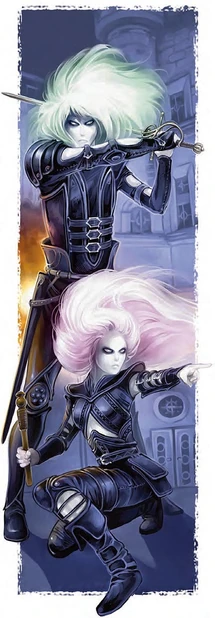
Changeling
One of the coolets thing about Eberron is the introduction of a bunch of new races that draw from D&D mythology while having their own very unique lore -- some of which have basically been 'imported' to mainstream D&D canon. Between the various Eberron sourcebooks, some of them have basically been given stats and artwork for 5E. So let's start off with the Changeling! I think 4E made them into bastard offsprings of the Dopplegangers, but the lore given in the Eberron books is that they were the children of a woman who made a desperate pact with an unknown being called 'The Traveler' to protect her children. These Changelings, thanks to the pact, are shunned by all but are able to Mystique-style transform their faces to copy anyone they see... which, naturally, as the Traveler promised, made everyone treat them with suspicion, while also ensuring them a skillset that allows them to survive. I also do like the little detail that the Changeling's shape-shifting abilities aren't always used for pragmatic reasons, but sometimes they just use it as a form of expression. Completely useless in gameplay, but I 100% absolutely love this little detail that makes them feel that much more of a race that have embraced shapeshifting as part of who they are. I also love the little detail that sometimes a community of Changelings will 'share' a couple of personas, with the example given being the fact that if there are three medics in a community, whoever is on duty will transform into "Tek", a persona that's their avatar for a kindly old medic. The "Tek" you might meet might not be the same Changeling, but they will strive to keep the personality of the Tek character. Roleplaying in a roleplaying game!
I really like that the "Rising form the Last War" sourcebook I borrowed to read through gives so much story potential when creating and playing a Changeling portrayal. It's just as likely that the Changeling is born in a stable community of Changelings where they're treated as normal folk; or if they're a nomadic group moving from place to place; or if they're born without understanding what they truly are. Again, I always very much appreciate it when a 'playable race' actually gives a lot of plot hooks and ideas on how a Changeling character might go through in their life.
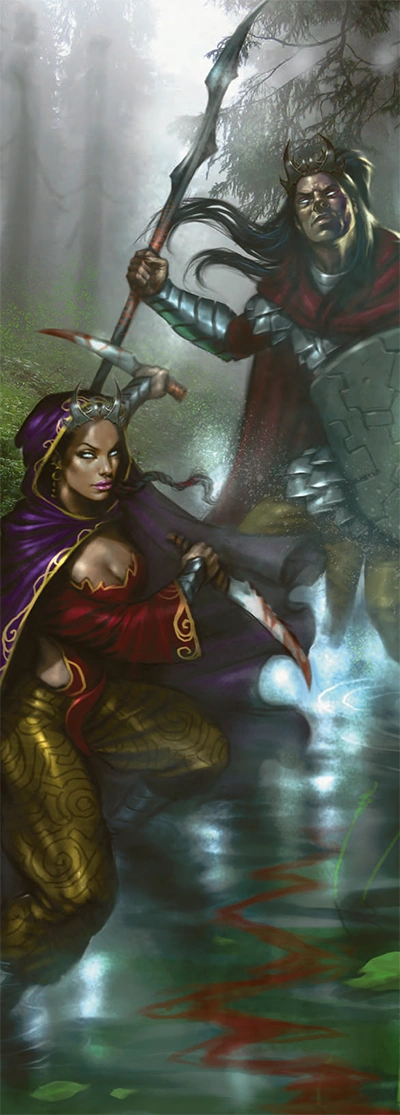
Kalashtar
I'm not the biggest fan of the Kalashtar, but I can see why they have a fair bit of a fanbase. They are created from the union of humanity and spirits called Quori from the plane of dreams. So they're basically spirit-bound people that are super-wise, supernaturally beautiful and super-likable (yawn), but always unsettling because they have a connection to the world of spirits. Oh, and they are also psions. That's certainly grossly oversimplifying things, sure, and there's a whole lot of fun to be done in roleplaying a character who views the world in quite literally a different way than everyone else. The 'linked spirit' thing also gives them an ability that I could sum up as "D&D Shaman King". But... I dunno, I just find them kind of 'not my thing'. I kind of feel like maybe they could've made them visually more distinct, because as it is Kalashtar just look like weird half-elves with eyes that sometimes glow. Still, I don't dislike them, and I appreciate that the setting has them.
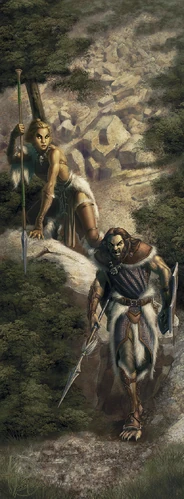
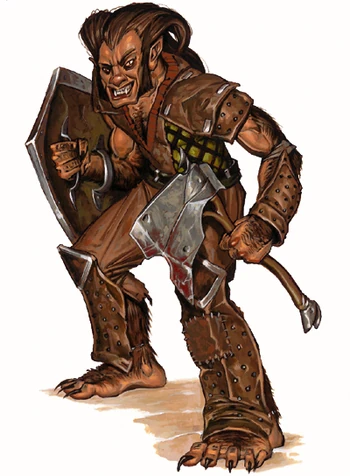
Shifter (a.k.a. Weretouched)
I actually played a Shifter character for a bit in a 5E one-shot, and knowing about them mostly from 4E stuff and from scattered 5E lists, I never realized that Shifters originated from Eberron! In 4E, Shifters were basically 'playable sane werewolves', and, come to think of it, was probably the setting's way to make sure that, no, not even the lycanthropes are always-chaotic-evil in this setting. The Shifters, whatever their origins were, have basically evolved into a distinct race where their lycanthropic part is no longer a curse or a disease or a condition, but simply part of who they are. They can't actually transform fully into a beast, but they can became a were-person, enhancing their beast-like features. As usual, this comes with all the tropes of 'teetering between being consumed by bestial rage' and all that, but it's nowhere as pronounced as D&D-style lycanthropy, which is almosts always portrayed as basically having a Jekyll-and-Hyde side you can't control.
Shifters are also not bound to any single animal, with each Shifter making a bond with their 'beast within', and depending on the Shifter in question, they might see the 'beast within' as an ancestral spirit, a natural spirit or simply an expression of their inner turmoil. Flexibility in character backstory, that's awesome. And the four sub-races in the Shifter race in 5E are basically based more on general groupings of animals -- "Beasthide" Shifters are durable animals like boars and bears; "Longtooth" Shifters are pack hunters like wolves; "Swiftstride" Shifters are speedy hunters like large cats or nimble rats; "Wildhunt" Shifters are any that track the prey.
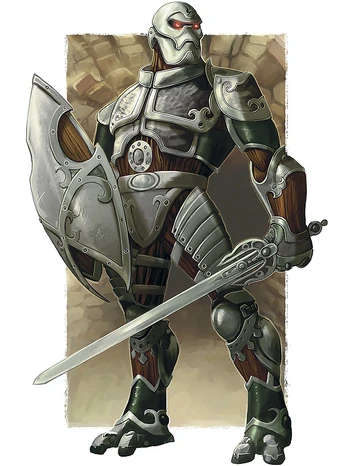
Warforged
And, last but certainly by far not the least, Eberron has motherfucking fantasy robots. Easily my favourite part of Eberron and another one that I've made a character out of, the Warforged were soldiers built by magic as mindless automatons to fight in Eberron's Last War. Originally nothing but mindless robots, eventually when they continued building and giving these magic robots more and more intelligence to better fight and wage war, at some point the Warforged actually became truly intelligent beings. They are made from wood and metal, and yet they can feel pain and emotion. With the Last War over, the Warforged have to accept that they are quite literally beings forged as weapons (it's in their name!) that have to find a place for themselves in the world. Throw in the typical angst about being built as a tool by another race, as well as the usual 'does this unit have a soul' sort of dilemma that these sort of sentient robots always have in fantasy, and the Warforged is just a pile of very, very interesting tropes ready to be explored. Best of all, the fact that their origin story is very much rooted in magical tinkering and war means that any DM can basically introduce them into any D&D setting with minimal fuss, just go "oh, a mage nation made these guys for war, and now they exist."
I really do love the unique aesthetic that the Warforged have, with their visible 'muscles' or 'skin' being wood, while their outer layer of armour being made of metal. All the Warforged, thanks to being 'mass-produced', all have the same facial design -- a hinged jaw, a reinforced brow ridge and glowing eyes. But other than the face and the wood-metal aesthetic, it's noted that Warforged can look pretty different from each other thanks to the specifics of their original intended function -- one of the NPC's in the book is a super-spiky Warforged called the Lord of Blades who looks absolutely badass.
Warforged Colossus & Titan
We are sort of jumping around the Rising from the Last War sourcebook, since stats for the Warforged as enemies also exist. And hey, turns out that the Warforged don't just exist as human-sized metal knights, but giant steampunk vresions of themselves also exist. I really do like the sense of scale here, and the fact that these giant robotic titans walk around with one huge hammer and a weird-looking blade. Why those weapons specifically? I'm not quite sure. I do really like the weird dome-shaped 'torso' of the Warforged Colossus, though, as do the weird grill-like mustache. Apparently these guys can alternate between being sentient robots or to be piloted with a battalion of mages inside the walking vehicles. They can either be Transformers or Gundams, that's pretty cool!
In Eberron's lore, most of these Colossi have the misfortune of being caught up in the Day of Mourning cataclysm the very day that they were deployed, but there are survivors who are simply deactivated, waiting to be reactivated. The sourcebook actually lists a bunch of specific locations and specific Colossi, which is definitely pretty fun if you play an Eberron setting! The 'Titan' variant are apparently smaller, and are like the prototypes of the Colossi.
Daelkyr
Pictured here are two of the Daelkyr as they appear in 5E, Belashyrra and Dyrrn. The Daelkyr are Lords of Madness, the main generals of a being called Xoriat, who invaded Eberron with an army of aberrations like beholders and mind-flayers. Apparently another staple from Eberron, 5E gives us stats for two of them while detailing the Daelkyr's story in pretty fun detail. Currently the Daelkyr are held behind a portal guarded by the Gatekeepers, keeping them as sealed evil beings... but that was thousands of years ago, and in present-day Eberron, the Gatekeepers are forgotten and the Daelkyr's minions are stirring.
The six main Daelkyr are Belashyrra, Lord of the Eyes (she masters hallucinations and Beholders); Drynn, the Corrupter (master of Mind Flayers and one of the biggest sources of twisting Eberron's denizens into aberrations); Avassh, the Twister of Roots (the source of unnatural vegetation like Shambling Mounds and Myconids); Kyrzin, the Prince of Slime (he makes oozes and gibbering beasts); Orlassk, the Master of Stone (he makes medusas, cockatrices and other creatures with petrification powers); Valaara, the Crawling Queen (he makes bug monsters).
As usual with these 'main villain' type characters, they look more or less humanoid. Belashyrra has a cool floating halo made out of eyeballs, and Drynn dresses in a pretty cool manner, but the Daelkyr are more important as villains and characters instead of just being monsters. It's an interesting way of incorporating aberrations and having them as one of the big bads of the setting (even if they don't look too aberrant themselves, at least in these 'forms') after most D&D stuff tended to resort to demons and devils as their main antagonists.
Dolgaunt
Yay actual weirdo monsters now! The Dolgaunt is an 'aberration', and look at this Resident Evil looking dude, with his emaciated flesh and a whole bunch of writhing tendrils jutting out of his head, shoulders and... armpit? For a moment I thought those tentacles emerged from his mouth and back, but turns out those are shoulder-flesh-whips. Apparently, these aren't some sort of undead, but rather are hobgoblins afflicted with a certain disease, and their flesh have mutated to sprout tentacles. The Dolgaunt is noted to be utterly blind (look at those empty eye sockets; it's like a Resident Evil Licker) and perceive the world around it with its 'cilia', making it feel like some sort of giant amoeba, then? That's so interesting! Its tentacles is able to absorb life, draining the vitality of any creature it meets. Again, it looks like just another generic flesh-vampire creature, but behaves more like a giant monocellular creature. I like it. These are some of the creatures created by and serving the Daelkyr.
Dolgrim
Where the Dolgaunt are sort of like the generals of the Daelkyr aberrations, the Dolgrim are footsoldiers. Being made out of goblins, these are noted to be 'two goblins crushed into one creature. I really like what we got here. Sure, giving a creature a hunchback and four arms isn't like anything new, but that face! Two mouths on top of each other, not quite fused togeher, and those ears -- with a pair of earholes on the left side of the head. The fact that the eyes seem to have fused properly and look like regular eyes makes the Dolgrim just a bit more terrifying than if you had two faces next to each other. The prose describing the Dolgrim in Rising from the Last War makes them sound so much more horrifying, too, noting that the Dolgrim has "a pair of twisted mouths that gibber and slather at the front of a headless torso". Not enough that their faces are pretty fucked up, turns out that what I've been seeing as a hunchback is actually the stump of a neck!
They're not actually all that dangeous for adventurers, but they show up in large numbers, have a lot of weaponry and are sometimes commanded by Dolgaunts. It's cool, I feel like an aberration 'footsoldier' might stand to just a bit more weird, but a goblin mutant that argues with itself with its two mouths is pretty all right for the 'grunt' of these aberrations.
Overlords
And now we have the Overlords, yet another group of villains; this time they are fiends! Pictured here are Rak Tulkhesh and Sul Khatesh. These 30+ Overlords once held dominion over Eberron until they were defeated, and imprisoned in a prison of celestial light, binding them in Khyber. They can't manifest in the world, but each overlord apparently embodies a particular aspect of evil, and grow stronger as mortals get tempted by their minions and embrace the dark paths laid down for them. Actually having them imprisoned by celestials and trying to break out of their prisons is a far, far more interesting way to have these absurdly powerful demon lords and arch-devils and yet not have them wipe out the material plane.
Rak Tulkhesh, the one on the right, is the "Rage of War" and that's a pretty badass look! A centaur-like body with wide dragon wings and spiky legs, Rak Tulkhesh also has a bunch of spikes being stabbed from the neck all the way to his tail, sort of resembling like spinal protrusions. He's got a cool eyeless face that's all spikes and shit, and being the embodiment of "the impulses that drives men to battle", he of course summons weapons. Sul Khatesh, the shadowy lady on the right, is the 'Keeper of Secrets' and embodies fear and superstition. Instead of getting power from people who are like, racist against warlocks and wizards or whatever, Sul Khatesh is happy to propagate the sterotype of evil warlocks and mad wizards by creating more on her own, empowering them with dark magics while drawing from the fear that they created. Pretty neat, if not quite as memorable as her brethren.
Rakshasa
The Rakshasa make a far larger appearance in Eberron, it seems, being involved in the backstory because they ruled an ancient civilization that once spanned all of Khorvaine. The Eberron books also includes the Zakya Rakshasa, which are far, far more bloodthirsty footsoldiers compared to the regular Rakshasa that are a bit more spellcaster-focused. S'neat. They're the goons of the Overlords.

Quori
You've got demons, you've got aberrations... but the coolest thing from this book, I feel, are the Quori -- who we briefly mention in the Kalashtar segment and easily the thing that keeps me from shit-talking the kalashtar for being boring. The Quori are beings that arrive from Dal Quor, the plane of dreams, and are all the embodiments of dreams and nightmares. These dream-beings can't actually manifest in the material plane, and to either be good or evil, they have to use hosts -- either the Kalashtar... or, if they're the evil Quori detailed here, the Inspired, who serve more like puppets than anything. Honestly, the existence of the Quori is perhaps the one biggest appeal I have about the Eberron setting, and there are a lot of cool shit about Eberron other than them. These bizarre dream-possessors have utterly bizarre plans and we're not quite sure just how deep the rabbit hole with them goes. Apparently most of the Quori are evil and serve the Dreaming Dark, but some renegade, good ones, hang out with the Kalashtar.
You've got demons, you've got aberrations... but the coolest thing from this book, I feel, are the Quori -- who we briefly mention in the Kalashtar segment and easily the thing that keeps me from shit-talking the kalashtar for being boring. The Quori are beings that arrive from Dal Quor, the plane of dreams, and are all the embodiments of dreams and nightmares. These dream-beings can't actually manifest in the material plane, and to either be good or evil, they have to use hosts -- either the Kalashtar... or, if they're the evil Quori detailed here, the Inspired, who serve more like puppets than anything. Honestly, the existence of the Quori is perhaps the one biggest appeal I have about the Eberron setting, and there are a lot of cool shit about Eberron other than them. These bizarre dream-possessors have utterly bizarre plans and we're not quite sure just how deep the rabbit hole with them goes. Apparently most of the Quori are evil and serve the Dreaming Dark, but some renegade, good ones, hang out with the Kalashtar.
Rising from the Last War gives us three Quori variants..
Tsucora Quori
The very first -- and weakest -- Quori sure does look like something born out of nightmares. Or at least from a Resident Evil game. The Tsucora have the lower body of flesh serpents, the arms of giant, mutated crabs, tiny sets of more humanoid arms... and then there's that face, what the fuck's going on there? Two glowing baleful blue eyes and a chopped-off nose, and then there is this swarm of multi-coloured eyes of different shapes just embedded randomly on his forehead like a bad case of acne. The result sure does look like something that's born out of someone's nightmares!
All these Tsucora are restless, jockeying for more powerful position among the Dreaming Dark and all want to basically ruin their competitors as they continue to further Dal Quor's plans. Being dream-spirits, all the Quori, I believe, are able to go around hunting and haunting the dreams of mortals, or, in the case of the Tsucora, take over the minds of their mortal worshippers and turning them into "Inspired". The Tsucora enjoy using fear and nightmares to keep human cattle in line, and this can extend to either mobs or high-ranking officials.
Hashalaq Quori
The next Quori we'll be talking about are the Hashalaq, and hoo boy, look at this weird motherfucker. This bizarre, serpentine (or phallic, if you prefer) body seemingly made entirely out of strands of... hair? String? Dream-stuff? With a whole bunch of tendril-arms and a single glowing eye as a 'face'? Yeah, this creature looks otherworldly, all right, and sure looks like something that would walk around in your dream. The Hashalaq are also called the "Dreamstealers", and apparently act as the loremasters and judges in Quori society. When interacting with us mere material-realm mortals, the Hashalaq Quori use their knowledge of human minds and basically weaponizes the power of pleasure and hedonism. In learning this the Hashalaq are also able to basically better control their Inspired cattle. And all that in-between acting as advisors to the higher-ranking Kalaraq, or acting as the lore-masters of Dal Quor, and also policing the other Quori. They basically do a lot of things, huh?
Easily my favourite of the three variants we see here in 5E. They actually used to look a lot more boring, just some robed dude without a face... which, admittedly, is still a pretty kickass design for a "Dreamstealer" creature, but this new redesign is so much more bizarre. For the most part, all these Quori seem to be pretty fun boss fight, with many psionic and possession abilities running around.
Kalaraq Quori
The most powerful 'lords' among the Quori are the Kalaraqs, or the "Eyebinders", and they look pretty cool! They also have a serpentine body like the Hashalaq, but with a far more pronounced upper body that looks somewhat like a bizarre insect, with a mantis-like head, mantis arms, three extra bug legs... and what is even going on with that swarm of little beady eyeballs that surround and swirl around it? Previous sourcebooks don't even have the bug-serpent look and have them look like humanoid specters. They are dream-beings, and are 'comprised of pure shadow outlined by a nimbus of energy', so, yeah, can't expect something like that to have a consistent look, can you?
These Kalaraqs guide the Quori race, and their boss, the "Devourer of Dreams", is of the Kalaraq caste. A pretty cool 'boss' for these dreaming creatures, although I personally find the more ephemeral-looking Hashalaqs far, far more unnerving than the Kalaraq.
These Inspired are the mortal hosts of the nightmare spirits of Dal Quor, basically acting as hosts for the evil Quori. They don't simply volunteer, they are actually bred to function optimally as the hosts of these dream-horrors. They're basically the evil version of the Kalashtar, and have differing powers depending on the Quori that has inhabited them. Not too much to say here that I haven't said in the Quori, although it's definitely important to give these guys stat blocks.
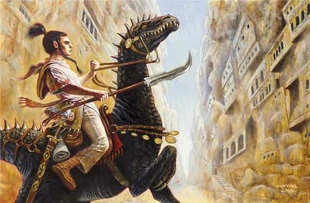
Dinosaurs: Clawfoot & Fastieth
Dinosaurs exist in Eberron, but since Eberron was released in the period of time in 3E and 4E where people inexplicably can accept Otyughs, Griffons and Spawns of Kyuss but regular dinosaurs, things that actually lived on earth in prehistoric times is somehow a bit of a taboo. Eberron's dinosaurs have slightly different names, but it's kind of clear what they are supposed to be. "Clawfoot" are clearly a Dromaeosaurid like a Deinonychus or something. The "Fastieth", pictured here, is some kind of non-carnivorous theropod. I do like the fact that it's explicitly noted that they have bright scales, cute large eyes and feathers.
Dusk Hag
We get another Hag variant in the Dusk Hag, who look... pretty weird! They've got faces that resemble masks, goat horns, a mass of hair behind that hair... I actually do like just how different this design looks compared to all the hags in the Monster Manual. These Dusk Hags are apparently able to see visions of the future in the dreams, and they can also use their magic to fuck with other people's dreams. Lots of people voluntarily work with Dusk Hags with the intent of divining the future from their visions, but on the other hand, being hags, the Dusk Hag is far more likely to do one of those 'twist the truth' style of manipulation that would cause more despair than anything else. Neat to have another hag, and I do like that this is specifically one that encourages less of a combative encounter.

Homunculi
Specifically a bunch of new clockwork-style Homunculi are given stats in Rising from the Last War, to tie in with one of the newer classes, Artificer. Hooray for more fantasy robots! Two such creatures are detailed here -- the Iron Defender is a pretty standard spiky angry metal dog, whereas the Expeditious Messenger is noted to be a skittery metal bird or sprite that carries messages on behalf of its creator. Again, I really do like this -- the fact that they're basically tying in these less-medieval sort of fantasy creatures with something like wizards is pretty neat.
Karrnathi Undead Soldier, Bone Knight & Undying
We get a bunch of stats for a bunch of undead creatures. They're all pretty cool, being skeleton clad in armour -- a pretty common trope in fantasy and one that I feel D&D has actually played down a fair bit to make their Death Knights feel just that more special. These undead variants certainly have their own long lore in Eberron, with Karrnathi Undead Soldiers being created out of desperation when Karrnath was crippled by famine and plague, and eventually regained intelligence, and after the war is over these angry undead troops are locked up somewhere because they could potentially be misused.
The Bone Knights serve under the Order of the Emerald Claw, and they apparently specifically craft their boney armour by pillaging the bones of those that they slay. Oh, and they're ex-paladins that are working for the lich Lady Illmarrow. As their name implies, they're basically Eberron's version of the Death Knight, albeit less of a badass independent undead and more of a part of an undead-based military. Apparently these bone-craft armour forces the paladins to channel their divine magic which somehow makes them more effective undead leaders.
The third undead person here is far, far cooler in concept even though, again, everyone here are just general sentient zombos. The Undying are undead that are sustained by positive energy or the devotion of mortal beings or powerful love, which plays well into 'all creatures might be good or evil'. It's basically the opposite of something like a ghost, where the Undying will be 'trapped' as an undead because of positive emotions, wanting to guide their community. Depending on the strength of the Undying, they can even separate their 'soul' into a light being (a light ghost!) from their desiccated corpse. Extremely interesting, and having the undead be actually good is a twist that I feel not enough fantasy fiction does.

Radiant Idol
An interesting one? The Radiant Idol is literally a fallen angel, as you can see by his tattered wings. He's a lawful evil celestial, having been cast out of the celestial realm due to the sin of wanting to be worshipped by mortals. And being in the mortal realm, they now want to gather cults to satisfy their need to be worshipped. They use a disguise self spell to look like their original angelic form, but when your adventurers eventually confront them, you can reveal their true form -- wings that are tattered stumps, or wings that are wrapped and weighted down with chains. Not my favourite enemy in this page, but a neat trope that I don't think D&D actually does enough.
Valenar Animals
And finally, we end with the Valenar Animals, which... are cool fey animals that are actually ancient elves of Valenar that, thanks to an ancient battle, were trapped and bound in their druidic animal forms. When a champion is worthy enough, some of these Valenar spirits will 'awaken' within an animal to help guide their descendants. Pretty cool idea of integrating some sort of ancestral worship and the idea of a spiritual guide. Not too much to say here, again, but a lot of these -- the various undead versions, the Radiant Idol, the Valenar animals... it really does help to paint a world that's similar but different than your standard D&D. And, hey, even if you don't want to play Eberron, at least the bits and bytes you read through skimming an Eberron book will at least help you craft a cool encounter or two!
_________________________________
That's it for the Eberron books, Acquisitions Inc. and the Waterdeep duology. The Eberron books are honestly a very, very fun read, and while I tried my best to not talk too much or wax lyrical about the setting, I really did enjoy what I glimpsed through my brief sojourn reading about the races and beasties in both Wayfinder and Rising from the Last War. Overall, a pretty fun read -- next up, though, we're going for some maritime adventures in one of the first non-core 5E D&D purchases I made.
The general stats block that I tend to do with these D&D reviews.
Waterdeep: Dragon Heist

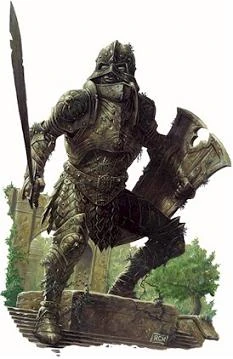
The stats for Apprentice Wizard, Bard, Gazer, Martial Arts Adept, Swashbuckler and Volothamp Geddarm are reprinted here.
- Ahmaergo: Medium humanoid - dwarf; lawful evil; CR 9
- Ammalia Cassalanter: Medium humanoid - human; lawful evil; CR 5
- Barnibus Blastwind: Medium humanoid - human; lawful good; CR 2
- Black Viper: Medium humanoid - human; chaotic neutral; CR 5
- Griffon Cavalry Rider: Medium humanoid - any race; any alignment; CR 2
- Davil Starsong: Medium humanoid - elf; neutral; CR 6
- Istrid Horn: Medium humanoid - dwarf; neutral evil; CR 8
- Skeemo Weirdbottle: Medium humanoid - gnome; neutral evil; CR 6
- Tashlyn Yafeera: Medium humanoid - human; neutral; CR 9
- Ziraj the Hunter: Medium humanoid - half-elf; neutral evil; CR 8
- Drow Gunslinger: Medium humanoid - elf; any alignment; CR 4
- Durnan: Medium humanoid - human; neutral; CR 9
- Hlam: Medium humanoid - human; lawful good; CR 16
- Hrabbaz: Medium humanoid - half-orc; neutral evil; CR 5
- Jalester Silvermane: Medium humanoid - human; lawful good; CR 4
- Jarlaxle Baenre: Medium humanoid - elf; chaotic neutral; CR 15
- Laeral Silverhand: Medium humanoid - human; chaotic good; CR 17
- Manshoon: Medium humanoid - human; lawful evil; CR 13
- Meloon Wardragon: Medium humanoid - human; neutral evil; CR 9
- Mirt: Medium humanoid - human; chaotic good; CR 9
- Nimblewright: Medium construct; unaligned; CR 4
- Remallia Haventree: Medium humanoid - elf; chaotic good; CR 9
- Vajra Safahr: Medium humanoid - human; lawful neutral; CR 13
- Victorio Cassalanter: Medium humanoid - half-elf; lawful evil; CR 10
- Walking Statue of Waterdeep: Gargantuan construct; unaligned; CR 18
Waterdeep: Dungeon of the Mad Mage


The stats for Archdruid, Champion, Githyanki Gish, Neothelid and Ulitharid are reprinted here.
- Halaster Blackcloak: Medium humanoid - human; chaotic evil; CR 23
- Lava Child: Medium humanoid - lava child; neutral; CR 3
- Living Unseen Servant: Medium construct; unaligned; CR 0
- Muiral: Large monstrosity; chaotic evil; CR 13
- Scaladar: Huge construct; unaligned; CR 8
- Shadow Assassin: Medium undead; chaotic evil; CR 9
- Werebat: Small humanoid - goblin shapechanger; neutral evil; CR 2
Acquisitions Incorporated
- Chaos Quadropod: Large aberration, chaotic evil, CR 4
- Clockwork Dragon: Medium construct, neutral, CR 1
- Deep Crow: Large monstrosity, unaligned, CR 9
- Ancient Deep Crow: Huge monstrosity, unaligned, CR 15
- Keg Robot: Medium construct, unaligned, CR 2
- Splugoth the Returned: Small humanoid (goblinoid), neutral evil, CR
The book actually stats a bunch of named characters. Including the Daelkyr generals Belashyrra and Dyrrn above, among the monsters here includes the Warforged general Lord of Blades, the Rakshasa warrior Mordakhesh and the lich Lady Illmarrow.
- Belashyrra: Medium aberration; chaotic evil; CR 22
- Dyrrn: Medium aberration; chaotic evil; CR 24
- Clawfoot: Medium beast; unaligned; CR 1
- Fastieth: Medium beast; unaligned; CR 1/4
- Dolgaunt: Medium aberration; lawful evil; CR 3
- Dolgrim: Small aberration; chaotic evil; CR 1/2
- Dusk Hag: Medium fey; neutral evil; CR 6
- Expeditious Messenger: Tiny construct; neutral; CR 1/8
- Iron Defender: Medium construct; neutral; CR 1
- Inspired: Medium humanoid - human; lawful evil; CR 2
- Karrnathi Undead Soldier: Medium undead; lawful evil; CR 3
- Lady Illmarrow: Medium undead; neutral evil; CR 22
- Living Burning Hands: Medium construct; unaligned; CR 1
- Living Lightning Bolt: Large construct; unaligned; CR 5
- Living Cloudkill: Large construct; unaligned; CR 7
- The Lord of Blades: Medium humanoid - Warforged; lawful evil; CR 18
- Mordakhesh: Medium fiend; lawful evil; CR 15
- Rak Tulkhesh: Huge fiend; neutral evil; CR 28
- Sul Khatesh: Large fiend; lawful evil; CR 28
- Hashalaq Quori: Medium aberration; lawful evil; CR 9
- Kalaraq Quori: Medium aberration; lawful evil; CR 19
- Tsucora Quori: Medium aberration; lawful evil; CR 7
- Radiant Idol: Large celestial; lawful evil; CR 11
- Zakya Rakshasa: Medium fiend; lawful evil; CR 5
- Undying Councilor: Medium undead; neutral good; CR 10
- Undying Soldier: Medium undead; neutral good; CR 2
- Valenar Hawk: Tiny fey; neutral; CR 1/8
- Valenar Hound: Medium fey; neutral; CR 1/2
- Valenar Steed: Large fey; neutral; CR 1/2
- Warforged Colossus: Gargantuan construct; unaligned; CR 25
- Warforged Titan: Huge construct; lawful neutral; CR 8
- Bone Knight: Medium humanoid - any race; non-good; CR 5
- Changeling: Medium humanoid - changeling, shapeshifter; any alignment; CR 1/2
- Kalashtar: Medium humanoid - kalashtar; any alignment; CR 1/4
- Magewright: Medium humanoid - any race; any alignment; CR 0
- Shifter: Medium humanoid - shifter; any alignment; CR 1/2
- Tarkanan Assassin: Medium humanoid - any race; non-good; CR 2
- Warforged Soldier: Medium humanoid - Warforged; any alignment; CR 1
Keep posting, your stuff is great!
ReplyDeleteThank you very much for the kind words!
DeleteI try to not let trolls bother me.